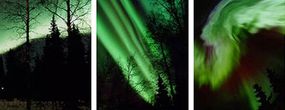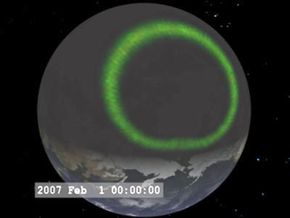February 24, 2007
On Saturday, February 17, NASA launched a rocket with a record-setting fivesatellitesonboard. The mission is to discover the source of an atmospheric phenomenon known as the "geomagnetic substorm." The satellites' respective orbits aim to provide varying views of these storms over the next several years to let scientists pinpoint the source of the magnetic disruptions that cause all sorts of problems on the ground, including communications disruptions and the disabling ofpower-distribution grids, and can damage satellites and pose radiation risks to astronauts in space. Geomagnetic substorms also brighten up the sky shows known as the "northern lights" or the "southern lights," also called the aurora. TheTHEMIS(Time History of Events and Macroscale Interaction during Substorms) mission is a pretty big one: Right now, no one knows what causes these fluxes in the Earth's magnetic field.
Advertisement
To understand the nature of a geomagnetic substorm, also known as amagnetospheric substorm, it's helpful to start at the very beginning: TheEarthhas its ownmagnetic field.
The Earth's core is composed of iron and nickel. This metal core acts as a bar magnet -- that's why you can navigate with amagnetism-based compass. The iron-nickel core is basically a magnet with two poles, one that points to the north, and one that points to the south. The Earth's north and south poles are therefore the points where the Earth's magnetism is strongest, and there is a constant movement of magnetism -- a magnetic field -- between these poles. But the Earth's magnetic field doesn't stop at the surface of the planet. It radiates thousands of miles into space in the form of magnetized bands that surround the planet.
Out in space, these magnetic bands interact with other magnetic fields and sources of energy. Most notably, theSun'senergy has a tremendous effect on the Earth's magnetism by way ofsolar winds. Solar winds are essentially bands of plasma -- extremely hot, charged particles, or electrons, of helium and hydrogen -- that escape from the Sun's surface. The particles are then blown around space by the Sun's energy. As these bands of plasma leave the Sun, they pull the Sun's magnetic field with them. Eventually, these solar winds reach a region of the Earth's atmosphere called the magnetosphere, and this is where geomagnetic substorms take place.
Themagnetosphereencompasses the upper level of Earth's atmosphere, which starts at more than 50 miles (80 km) above the ground, and extends far out into space. Ions in the magnetosphere never come together to form neutrally charged molecules -- they remain apart due partly to the interaction between the Earth's magnetic field and the Sun's magnetic field. The pushing and pulling of interplanetary magnetism actually causes the magnetosphere to be tear-shaped, not spherical, as the magnetized bands are pulled toward and away from the Earth at irregular intervals depending on the activity of the solar winds.
When the solar winds, carrying massive amounts of energy (in the form of charged plasma particles) and magnetism, enter the Earth's magnetosphere, the magnetosohere's own charged particles become very excited. The energy released in the excitement of the ions causes a surge in magnetism and radiation -- and emits incredible amounts of light in the process. This light is what we call the northern lights, oraurora. The aurora is a visual display of the energy released in the interaction between the solar winds and Earth's magnetosphere over polar skies, where magnetism is greatest.
This interaction occurs often and is often harmless. But at times, when solar winds hit the magnetosphere, there is a major disruption in the Earth's magnetic field. This is ageomagnetic substorm, and you can see how this disruption is reflected in the aurora pictured below:

During a geomagnetic substorm, the interaction between the solar winds and the magnetosphere is particularly violent, causing the border of the magnetosphere to be pushed toward Earth. This interferes with the Earth's ionosphere, the collection of charged particles in the upper portion of Earth's atmosphere whereradiocommunications travel (seeWhy do you hear some radio stations better at night than in the day?)。在地磁亚暴,耳朵的乐队th's magnetic field get interrupted: They separate and then snap back together. This disruption throws tremendous amounts of radiation toward the surface of the planet. This can result in power outages, damage to satellites and spacecraft, radio interference, disruption in navigation systems and other problems related to the surge of magnetic energy in Earth's atmosphere. And no one knows exactly how these storms get started.
Current scientific theory is divided between hypotheses about the origins of geomagnetic substorms. These hypotheses basically differ in terms of which component of the interaction that results in a substorm -- the magnetosphere or the solar winds -- is holding the trigger for the process. Over the next several years, scientists hope to receive data from the five THEMIS satellites that will provide insight into which of the prominent theories is correct. Of course, they may just end up proving everybody wrong.
For more information on geomagnetic substorms, atmospheric science and related topics, check out the following links.
- 指南针是如何工作的
- How the Earth Works
- How Satellites Work
- How the Sun Works
- CNN.com: NASA launches five-satellite rocket - Feb. 18, 2007
- NASA: A Primer on Space Weather
- NASA: The Magnetosphere
Sources
- “一个Primer on Space Weather." Space Environmental Center. NASA.gov. http://www.sec.noaa.gov/primer/primer.html
- "Geomagnetic field." Encyclopædia Britannica. http://www.britannica.com/eb/article-9036468/geomagnetic-field
- "NASA launches five-satellite rocket." CNN.com. Feb. 18, 2007. http://www.cnn.com/2007/TECH/space/02/18/themis.mission.ap/index.html
- "NASA's Themis Mission Launches To Study Geomagnetic Substorms." SpatialNews. Feb. 19, 2007. http://spatialnews.geocomm.com/dailynews/2007/feb/19/news6.html
- "THEMIS Will Judge What Causes Highly Dynamic Aurora." NASA.gov. Jan. 17, 2007. http://www.nasa.gov/mission_pages/themis/news/Themis_intro.html
Advertisement




